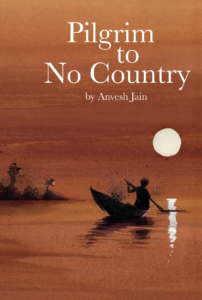by Jaclyn Pahl
Pilgrim to No Country
by Anvesh Jain
Frontenac House (2022)
In his debut poetry collection, Pilgrim to No Country, Anvesh Jain promises to “pen the great ironies of [his] displaced kind.” Jain traces his life experiences as an Indian-Canadian immigrant, combining postmodern meta-commentary with a longing for spiritual resolution. Jain’s poems are peppered with a prodigious array of literary, cultural, and religious references. The boundaries of nation, of place and time, of, even, blood seem to trap the speaker in the cruelty and monotony of flesh-bound existence. There is a battle for self-identification as much as there is a battle to accept the confinement that comes with identification. In open defiance of these constraining realities, Jain makes the case for going. In Pilgrim to No Country geographies and histories conflate to create an unconfined territory that seems more than just topological. Circumventing the arbitrary borders that are imposed on the human spirit, Jain shows us there is humour, enthusiasm, and hope to be found in the transcendence of boundary. “This is for the optimism of leaving,” writes Jain in the second poem of his collection, “To Puffer Vests Over Kurtas and Dad’s Plaid Shirts.” Jain reaches for the status of national poetry, overlaying Canadian geography with American symbolism. Jain writes of an “indomitable flame,” conjuring the Statue of Liberty and referencing the promises made to the immigrants who voyaged to the United States in centuries prior. Jain’s descriptions move from the grandiose to the particular in sweeping motions—from broad, enamelled statements down to cutlets of idiosyncratic detail: from “debarkation on sky-waters and salt-ice flows” to “cold coffee in Connaught Place.” American influence creeps into the collection at intervals. Though both Jain and Whitman are separately influenced by Hinduism, there is a decidedly Whitmanian tinge to Jain’s “many-named universe of myself,” a line that appears in a later poem “Golgappa.”
The line’s subtle emphasis on individualism lends it American character. The poem “Yamnuska Wolfdog Sanctuary” loosely evokes Kerouac: the car-bound group of mavericks who take to the open West, “[losing] the car at Cheneka,/At Ghost Lake [losing] the soul,” and refusing to “piss on sacred soil.”
Jain’s evocation of the American tradition is hardly unqualified. His rejection of sentimentality in “Tiffin Box” conveys a wholly un-American contempt for nostalgia. To what extent the Canadian literary tradition will borrow from the American tradition remains an open question, and Jain (like all Canadian writers who take up the task) is doing the grunt work of building a literary identity around Canada, which, as such, is still an unsuspecting and unlikely subject for a writer.
The question of nationhood vanguards Jain’s collection. In “Voyages,” Jain transubstantiates a cup of chai into India’s colonial history, and in doing so manifests the warmest and most self-contained poem in the collection. In “The Immigrant Steadies His Defence” the question of nation is cross-examined. Judge Samson sits holding a “punishing scorecard” as the “immigrants line up to pass.” As Samson sits, judging the immigrants like Peter at the gates of heaven, the question of nation becomes one of spiritual affiliation. The tension between kingdom and exile is relieved when Immigrant Enkidu fires a gunshot back at the judge —“a marksmen among [them] at last.” The judge’s death is a “transcendental deed.” The power that the guards of the nation once held is neutralized and dispersed. Here, as throughout the collection, Jain seeks to overcome boundary. If all boundary stems from the final boundary between life and death, then the Immigrant’s true battle is the demystification of this boundary. In this, Jain suggests that death, too, is a process of going.
But the highlights of the collection come when Jain holds the distinction between boundaries. In “Durgotsava Festival at Irvine, California” Jain explores the boundary between the mystic and material, the ancient and the modern, and the innocent and the demonic. Set on “California’s darkened shoreline,” we watch “worshippers unload torches/And ice-boxes from parked SUVs” and then march in procession “to the sea,” gathering the “strength to defeat/ Demonic Asuric forces.” “Worshippers carrying Durga’s statue/Dissolve in the angry Pacific,” as “tweens at the beach giggle” and “make TikToks of the boiling waves.” The sea: dark, angry, and expansive, represents the chaotic energy of the universe that encroaches on the festival. The “tweens” seem naive to both the dark forces beyond the shoreline and the significance of the holy gathering around them. Their innocence lingers between the sea and the sheltering glow of the festival’s flames. The poem is incandescent and hopeful—as the innocent are sheltered and, it seems, the demonic forces are kept at bay.
The theme of isolation hangs over Jain’s collection. Jain derives his title from a quote from poet Rabindranath Tagore. Tagore writes of a couple who set off in a boat “to no country and to no end.” But while Tagore’s pilgrimage is between two lovers, who drift, romantic and nihilistic, on a sailboat far beyond the reach of humanity, Jain’s pilgrimage is a solitary one. Pilgrim to No Country is an exploration of nation. The nation, on a symbolic level, is representative of the comforts of commonality and belonging: a kingdom to which one can marry the soul. The nation is also a name, and with a name comes identity. But Jain’s pilgrim is bound, ultimately, for no country. He will be a pilgrim forever, or, at least, until forces of greater unity can unbind him from circumstance both earthly and semantic. So, Jain suggests, we pilgrims must go on.
